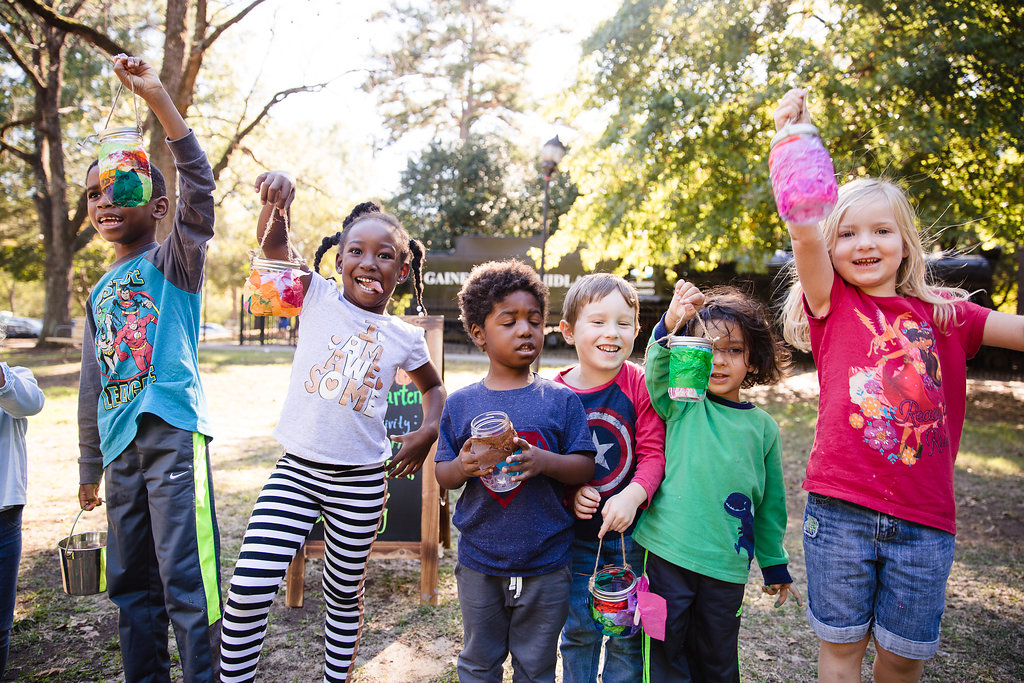Metaphorically, we are always planting seeds of inspiration for project play and new ways of exploring nature with children.
But when we dedicated a season of Tinkergarten classes to a literal study of seeds, we were thrilled to see what families brought to (and pulled from) our #PlantASeed project.
By design (like all our Tinkergarten activities), it’s quite simple. In the first class, we gave each family a packet of seeds and some directions about how to plant and nurture them into seedlings. Then, we all waited, watched and observed the magical moment when brave, green sprouts poked up through the soil.
Though I do not believe that a plant will spring up where no seed has been, I have great faith in a seed... Convince me that you have a seed there, and I am prepared to expect wonders. — Henry David Thoreau
What can you teach (and learn) from planting seeds with young kids?
You truly do not have to have a green thumb to make this experience transformative for your little sprouts. Here are just a few of the lessons we’ve pulled from planting seeds as a family:
Multisensory learning: Children activate multiple senses when they prep the soil, investigate seeds, water or mist and observe the bright green seedlings.
Patience: So many experiences are quickly, if not instantly, gratifying these days. But, watching a pot of soil for the appearance of a tiny seedling still happens on nature’s time. Just like the little boy in Ruth Krauss’s Carrot Seed, children can see that patience pays off, as that moment when you finally see green is like magic.
STEM skills: Even young children can get exposed to biology by observing seedings. Also, when you stop each day to observe, talk about, and even document what you notice is happening with your seedlings, you model how to think and act like a scientist. Children are born STEM learners, and activities to develop curiosity further like this teach them how to use observation in an investigative way.

Empathy: When you make it a family ritual to water the seedlings each day, children gain experience with caring for another living thing and learn that they have agency in supporting their seeds. It’s a natural way of developing empathy in children.
Serenity and reverence: Some seedlings thrive, transplant well and go on to be healthy plants. Many do not. The same is true in nature. Read Eric Carle’s The Tiny Seed once, and it’s a celebration of the persistence of the tiny seed. Read it again, and you realize that the majority of seeds in the book never get a chance—such is true in nature.
So, if your seedlings do not persist, that is OK. In fact, it’s a great lesson about life. It may also be a reminder to you, and even to your wee ones, that every plant we see around us has a truly remarkable survival story. When you think about that, each plant we see in our environment is an even bigger marvel than before.
If all seeds that fall were to grow, then no one could follow the path under the trees. — Akan proverb
Try planting seeds at home!
Check out our “Planting Seeds” DIY activity; it’s also a great way to bring the outdoors inside. Here are some options for how to learn with kids, once your seedlings are up:
Observing seedlings:
- Notice: Talk together about what comes up and how it changes over the days. Look at the differences between the simple “seed” leaves (known as cotyledons) and the “true” leaves of the plant that follow. Pull out one seedling and look at its root and its shoot.
- Draw or photograph what you notice each day, so you can look at the change over time. Share your photos using #Tinkergarten and #PlantASeed.
- Measure: Do not expect wee ones to understand standard measurement, but model measuring how many centimeters tall your seedlings are and talk about it with your child, sharing your excitement and interest. See how many centimeters tall your child is!
What next for seedlings?
Seedlings can be hard to nurture into full plants, but worry not, there is much to learn no matter which path your seedlings take. Some options:
- Transplant your seedlings: If you would like to keep growing your seeding, wait until it has several weeks of growth, then either transplant it to a larger indoor pot or start to prepare it for planting outdoors.
- Acclimating seedlings: If your seedlings have grown up indoors, start to put the pots outdoors for long periods of time for a few days, avoiding rough weather. This will prepare them for successful planting in their new outdoor home.
- Thin out your seedlings: If you have many seedlings growing right next to one another, you need to gently pull seedlings so that a few have the chance to thrive. It can seem hard, but it is actually a great way to observe the full seedling, and you can still use the pulled seedlings to observe how the plants in our world that do not survive change and turn back into soil.
- If all seedlings peter out: You have learned so much just in the planting, sprouting and observing. A final lesson in composting is a great way to close this exploration!
Extending the learning:
- Harvest and taste the plants, if edible.
- Try this marvelous fruit seed investigation from Scientific American’s Science Buddies.
- Learn more through literature by reading books like Carrot Seed by Ruth Krauss, The Tiny Seed by Eric Carle, or How Groundhog’s Garden Grew by Lynne Cherry.
- Start to learn together about trees, nature’s greatest teachers.
- Try again with a new variety of seeds!
